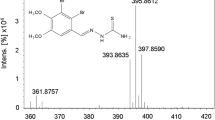Abstract
An HPLC–peroxyoxalate chemiluminescence (PO-CL) method for simultaneous determination of methylphenidate (MPH) and ritalinic acid (RA) was developed. The method was used to monitor MPH and RA after administration of MPH to rats. Deproteinized plasma spiked with 1-(3-trifluoromethylphenyl)piperazine (IS) was dried and labeled with 4-(N,N-dimethylaminosulfonyl)-7-fluoro-2,1,3-benzoxadiazole (DBD-F). The labeled sample was cleaned with two kinds of solid-phase extraction cartridge, and the DBD-labels were separated on an ODS column with gradient elution using a mixture of CH3CN and imidazole–HNO3 buffer. Separation of MPH and RA can be achieved within 33 min. The LODs of MPH and RA at a signal-to-noise ratio of 3 were 2.2 and 0.4 ng mL−1, respectively. Moreover, monitoring of MPH and RA after MPH administration (10 mg kg−1) to rat could be performed. The concentration of RA 480 min after administration was eight times higher than that of MPH. The proposed HPLC–PO-CL method was useful for determination of MPH and RA in rat plasma and was successfully used to monitor these substances after MPH administration.




Similar content being viewed by others
References
Volkow ND, Fowler JS, Wang GJ, Ding YS, Gatley SJ (2002) Role of dopamine in the therapeutic and reinforcing effect of methylphenidate in humans: results from imaging studies. Eur Neuropsychopharmcol 12:557–566
Patrick KS, Straughn AB, Minhinnett RR, Yeatts SD, Herrin AE, DeVane CL, Malcolm R, Janis GC, Markowitz JS (2007) Influence of ethanol and gender on methylphenidate pharmacokinetics and pharmacodynamics. Clin Pharmacol Ther 81:346–353
Wargin W, Patrick K, Kilts C, Gualtieri CT, Ellington K, Mueller RA, Kraemer G, Breese GR (1983) Pharmacokinetics of methylphenidate in man, rat and monkey. J Pharmacol Exp Ther 226:382–386
Kimko HC, Cross JT, Abernethy DR (1999) Pharmacokinetics and clinical effectiveness of methylphenidate. Clin Pharmacokinet 37:457–470
Sun Z, Daryl J, Sanghani SP, Davis WI, Kedishvili NY, Zou Q, Hurley TD, Bosron WF (2004) Methylphenidate is stereoselectively hydrolyzed by human carboxylesterase CES1A1. J Pharmacol Exp Ther 310:469–476
Masselo W, Capenter DA (1999) A fatality due to the intransal abuse of methylphenidate (Ritalin). J Forensic Sci 44:220–221
Marchei E, Farrè M, Pellegrini M, Rossi S, Algar OG, Vall O, Pichini S (2009) Liquid chromatography–electrospray ionization mass spectrometry determination oh methylphenidate and ritalinic acid in conventional and non-conventional biological matrices. J Pharm Biomed Anal 49:434–439
Doerge DR, Fogle CM, Paule MG, Mccullagh M, Bajic S (2000) Analysis of methylphenidate and its metabolite ritalinic acid in monkey plasma by liquid chromatography/electrospray ionization mass spectrometry. Rapid Commun Mass Spectrom 14:619–623
Barbarin N, Mawhinney DB, Black R, Henion J (2003) High-throughput selected reaction monitoring liquid chromatography–mass spectrometry determination of methylphenidate and its major metabolite, ritalinic acid, in rat plasma employing monolithic columns. J Chromatogr B 783:73–83
Sticht G, Sevecke K, Käferstein H, Döpfner M, Rothschild MA (2007) Detection of methylphenidate in the hair of children treated with ritalin. J Anal Toxicol 31:588–591
Chan YM, Soldin SJ, Swanson JM, Deber CM, Thiessen JJ, Macledo S (1980) Gas chromatographic/mass spectrometric analysis of methylphenidate (Ritalin) in serum. Clin Biochem 13:266–272
Zhang J, Deng Y, Fang J, Mckay G (2003) Enantioselective analysis of ritalinic acid in biological samples by using a protein-based chiral stationary phase. Pharm Res 20:1881–1884
Soldin SJ, Chan YM, Hill BM, Swanson JM (1979) Liquid-chromatographic analysis for methylphenidate (ritalin) in serum. Clin Chem 25:401–404
Soldin SJ, Hill BM, Chan YM, Swanson JM, Hill JG (1979) A liquid-chromatographic analysis for ritalinic acid [α-phenyl- α -(2-piperidyl)acetic acid] in serum. Clin Chem 25:51–54
Zhu HJ, Wang JS, Patrick KS, Donovan JL, Devane CL, Markowitz JS (2007) A novel HPLC fluorescence method for the quantification of methylphenidate in human plasma. J Chromatogr B 858:91–95
Lindsay DC, Markowitz JS, Carson SW, Boulton DW, Gill HS, Ziah N, Craig RS (2000) Single-dose pharmacokinetics of methylphenidate in CYP2D6 extensive and poor metabolizers. J Clin Psycopharmacol 20:347–349
Marchei E, Muñoz JA, Alger ÓG, Pellegrini M, Vall O, Zuccaro P, Pichini S (2008) Development and validation of a liquid chromatography–mass spectrometry assay for hair analysis of methylphenidate. Forensic Sci Int 176:42–46
Fernandez MMR, Laloup M, Wood M, Boeck GD, Rivadulla ML, Waĺlemacq P, Samyn N (2007) Liquid chromatography–tandem mass spectrometry method for the simultaneous analysis of multiple hallucinogens, chlorpheniramine, ketamine, ritalinic acid, and metabolite, in urine. J Anal Toxicol 31:497–504
Eichhorst J, Etter M, Lepage J, Lehotay DC (2004) Urinary screening for methylphenidate (Ritalin) abuse: a comparison of liquid chromatography–tandem mass spectrometry, gas chromatography–mass spectrometry, and immunoassay methods. Clin Biochem 37:175–183
Nakashima K, Ikeda R, Wada M (2009) Analytical studies on the development of high-performance liquid chromatographic methods with fluorescence or chemiluminescence detections and their practical applications. Anal Sci 25:21–32
Nakamura S, Wada M, Crabtree BL, Reeves PM, Montgomery JH, Byrd HJ, Harada S, Kuroda N, Nakashima K (2007) A sensitive semi-micro column HPLC method with peroxyoxalate chemiluminescence detection and column switching for determination of MDMA-related compounds in hair. Anal Bioanal Chem 387:1893–1990
Author information
Authors and Affiliations
Corresponding author
Additional information
Published in the special issue Analytical and Bioanalytical Luminescence with Guest Editor Petr Solich.
Rights and permissions
About this article
Cite this article
Wada, M., Abe, K., Ikeda, R. et al. HPLC determination of methylphenidate and its metabolite, ritalinic acid, by high-performance liquid chromatography with peroxyoxalate chemiluminescence detection. Anal Bioanal Chem 400, 387–393 (2011). https://doi.org/10.1007/s00216-011-4713-0
Received:
Revised:
Accepted:
Published:
Issue Date:
DOI: https://doi.org/10.1007/s00216-011-4713-0




